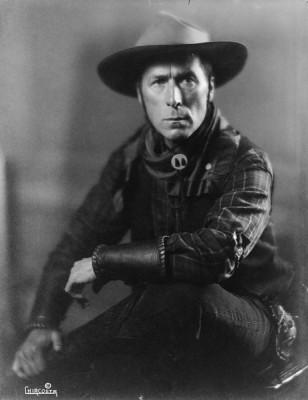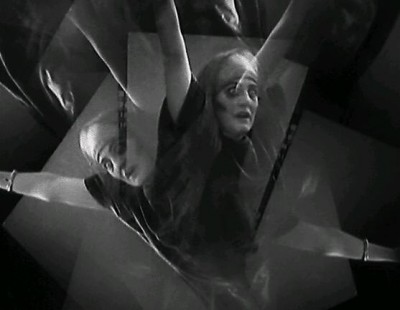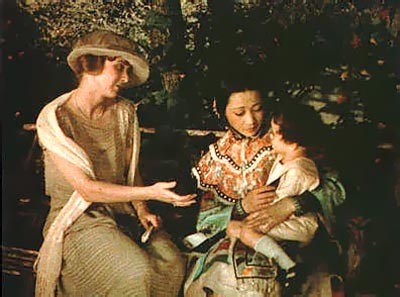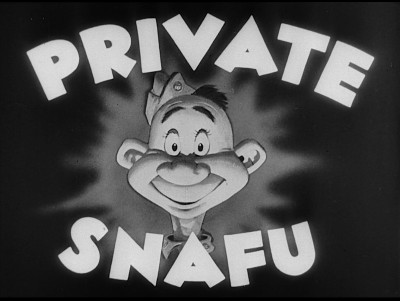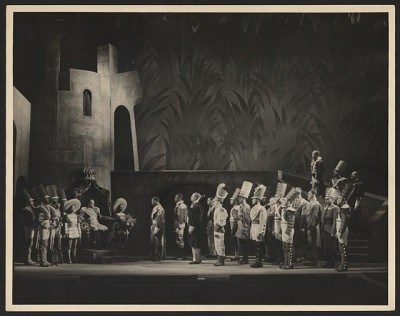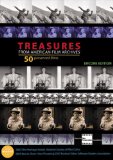| Reviews & Columns |
|
Reviews DVD TV on DVD Blu-ray 4K UHD International DVDs In Theaters Reviews by Studio Video Games Features Collector Series DVDs Easter Egg Database Interviews DVD Talk Radio Feature Articles Columns Anime Talk DVD Savant Horror DVDs The M.O.D. Squad Art House HD Talk Silent DVD
|
DVD Talk Forum |
|
|
| Resources |
|
DVD Price Search Customer Service #'s RCE Info Links |
|
Columns
|
|
|
Treasures From American Film Archives - Encore Edition
Now I realize it's worth every penny and then some. I've watched thousands of DVDs of all kinds - but Treasures from American Film Archives easily ranks among the best-organized, most thoughtful and ultimately fascinating - and at times exhilarating collections I've ever come across. It's not so much a "Best of the Archives" gathering you watch but a unique, frequently revelatory viewing experience. The set is cleverly, indeed ingeniously compiled and packaged, drawing viewers to subjects and genres they otherwise might never experience. Critical to its appeal, the all-region set comes with extremely well-written and detailed booklets with very useful and interesting information about each title. I can't recommend this set enough.
William S. Hart, star of Hell's Hinges
From the National Film Preservation Foundation's own website, here's a complete list of titles and brief descriptions, listed by Archive:
from Academy Film Archive, Academy of Motion Picture Arts and Sciences™
Luis Martinetti, Contortionist (1894, 1 minute), peepshow kinetoscope of the Italian Acrobat made by the Edison Co.
Caicedo, King of the Slack Wire (1894, 1 minute), the first film shot outdoors at the Edison Studios.
The Original Movie (1922, 8 minutes), silhouette animation satire on commercial filmmaking, by puppeteer Tony Sarg.
Negro Leagues Baseball (1946, 8 minutes), footage featuring Reece "Goose" Tatum, the Indianapolis Clowns, and the Kansas City Monarchs.
Alaska Film Archives, University of Alaska Fairbanks
The Chechahcos (1924, 86 minutes), first feature shot entirely on location in Alaska.
Anthology Film Archives
Rose Hobart (1936, 19 minutes), artist Joseph Cornell's celebrated found-footage film.
Composition 1 (Themis) (1940, 4 minutes), Dwinell Grant's stop-motion abstraction.
George Dumpson's Place (1965, 8 minutes), Ed Emshwiller's portrait of the scavenger artist.
George Eastman House
The Thieving Hand (1908, 5 minutes), special-effects comedy.
The Confederate Ironclad (1912, 16 minutes), Civil War adventure, here accompanied by the original music score, in which the tough heroine saves the day.
The Land Beyond the Sunset (1912, 14 minutes), social problem drama about a tattered newspaper boy who yearns for a better life.
Snow White (1916, 63 minutes), live-action feature of the Brothers Grimm tale starring Marguerite Clark.
The Fall of the House of Usher
The Fall of the House of Usher (1928, 13 minutes), avant-garde landmark created by James Sibley Watson, Jr., and Melville Webber from Poe's short story.
Japanese American National Museum
From Japanese American Communities (1927-32, 7 minutes), home movies shot by Rev. Sensho Sasaki in Stockton, California, and Tacoma, Washington.
Library of Congress
Demolishing and Building Up Star Theatre (1901, 1 minute), the time-lapse demolition of a New York building, preserved from a paper print.
Move On (1903, 1 minute), Lower East Side street scene, preserved from a paper print.
Dog Factory (1904, 4 minutes), trick film about fickle pet owners, preserved from a paper print.
Princess Nicotine; or, The Smoke Fairy (1909, 5 minutes), special-effects fantasy of a tormented smoker, by the Vitagraph Company.
White Fawn's Devotion (1910, 11 minutes), probably directed by James Young Deer and the earliest surviving film by a Native American.
Minnesota Historical Society
Cologne: From the Diary of Ray and Esther (1939, 14 minutes), small town portrait by amateur filmmakers, Dr. and Mrs. Dowidat.
Museum of Modern Art
Blacksmithing Scene (1893, 1 minute), first U.S. film shown publicly.
The Gay Shoe Clerk (1903, 1 minute), comic sketch with celebrated early editing.
Interior New York Subway, 14th St. to 42nd St. (1905, 5 minutes), filmed by Biograph's Billy Bitzer shortly after the subway's opening.
Hell's Hinges (1916, 64 minutes), William S. Hart Western about a town so depraved that earns its own destruction.
The Lonedale Operator (1911, 17 minutes), D.W. Griffith's race-to-the-rescue drama, starring Blanche Sweet.
Three American Beauties (1906, 1 minute), with rare stencil color.
National Archives and Records Administration
We Work Again (1937, 15 minutes), WPA documentary on African American re-employment, including excerpt from Orson Welles' stage play of "Voodoo Macbeth."
The Autobiography of a Jeep (1943, 10 minutes), the story of the soldier's all-purpose vehicle, as told by the jeep itself.
Private Snafu: Spies (1943, 4 minutes), wartime cartoon for U.S. servicemen, directed by Chuck Jones and written by Dr. Seuss.
The Battle of San Pietro (1945, 33 minutes), celebrated combat documentary directed by John Huston.
The Wall (1962, 10 minutes), USIA film on the Berlin Wall made for international audiences.
National Air and Space Museum, Smithsonian Institution
From The Keystone "Patrician" (1928, 6 minutes), promotional film for new passenger plane.
From The Zeppelin Hindenburg (1936, 7 minutes), movies by a vacationing American family made on board this famous lighter-than-air-craft, one year before its destruction.
National Center for Jewish Film
From Tevye (1939, 17 minutes), American Yiddish-language film, directed by Maurice Schwartz, adapted from Sholem Aleichem's stories.
National Museum of American History, Smithsonian Institution
From Accuracy First (ca. 1928, 5 minutes), Western Union training film for women telegraph operators.
From Groucho Marx's Home Movies (ca. 1933, 2 minutes).
National Museum of Natural History, Smithsonian Institution
From Beautiful Japan (1918, 15 minutes), early travel-lecture feature by Benjamin Brodky.
New York Public Library
From La Valse (1951, 6 minutes), pas de deax from George Balanchine's 1951 ballet, featuring Tanaquil Le Clercq and Nicholas Magallanes and filmed at the Jacob's Pillow Dance Festival.
Battery Film (1985, 9 minutes), experimental documentary of Manhattan, by animator Richard Protovin and photographer Franklin Backus.
Northeast Historic Film
From Rural Life in Maine (ca. 1930, 12 minutes), footage filmed by Elizabeth Wright near her farm of Windy Ledge, in southwestern Maine.
From Early Amateur Sound Film (1936-37, 4 minutes), scenes of family life captured by sound-film hobbyist Archie Stewart.
Pacific Film Archive
Running Around San Francisco for an Education (ca. 1938, 2 minutes), early political ad, shown in San Francisco theaters, that helped win approval of local school bonds.
OffOn (1968, 9 minutes), Scott Bartlett's avant-garde film, the first to fully merge film and video.
UCLA Film & Television Archive
Her Crowning Glory (1911, 14 minutes), household comedy, with comic team John Bunny and Flora Finch, about an eight-year old who gets her way.
I'm Insured (1916, 3 minutes), cartoon by Harry Palmer.
Anna May Wong in The Toll of the Sea
The Toll of the Sea (1922, 54 minutes), Anna May Wong in an early two-strip Technicolor melodrama, written by Frances Marion, and here accompanied a performance of the original music score.
The News Parade of 1934 (10 minutes), Hearst Metrotone newsreel summary of the year.
From Marian Anderson: The Lincoln Memorial Concert (1939, 8 minutes), excerpt from a concert film, reconstructed from newsreels, outtakes, and radio broadcast materials.
West Virginia State Archives
From West Virginia, the State Beautiful (1929, 8 minutes), amateur travelogue along Route 60.
From One-Room Schoolhouses (ca. 1935, 1 min), amateur footage from rural Barbour County.
Treasures from American Film Archives is nearly 11 hours of surprises and unexpected delights, and its fascinations often transcend the movies' original intentions. For instance, with many of the earliest films, the pre-1910 ones, it's hard not to watch those and marvel at how they've managed to capture a period of American history that essentially has vanished forever. When I was a child, many early silent film stars and filmmakers were still around (being interviewed by silent era historian Kevin Brownlow, no doubt) but today, even the infants seen in these movies, if still alive, would be over a hundred years old now. Pictures like Move On, Demolishing and Building Up Star Theatre, and the incredible Interior New York Subway, 14th St. to 42nd St. offer time machine-like glimpses into the past whose appeal, in one sense, has come full circle. At the turn of the century, audiences marveled at pictures that could move, simple scenes brought to life, while 100-plus years later modern viewers watch these DVDs on big-screen TVs transfixed by the turn of the century fashions, at the early streetcars, the horse-drawn carriages, the playing children, busy street vendors, and threatening policemen - and imagine what daily life might have been like for these ghostly people immortalized on film.
Curators Scott Simmon and Martin Marks also chose to include a number of obscurities filmed outside the burgeoning film industry, amateur films like the pastoral Rural Life in Maine (ca. 1930), which captures a farming family working and picnicking through the seasons; and The Chechahcos (1924), an old-fashioned melodrama even by 1924 standards, but notable as an early feature independently-produced by Alaskans, a film that at once takes advantage of the incredible scenery but made with a professional polish that belies its modest roots.
Varied U.S. government-produced films are included. The Autobiography of a Jeep (1943) is slickly-made, entertaining wartime propaganda, as is the surprisingly off-color Private Snafu cartoon Spies (1943), directed by the great Chuck Jones and featuring rhythmic dialogue by Theodor Geisel - Dr. Seuss. But these are balanced by John Huston's harrowing, controversial The Battle of San Pietro (1945), arguably the most brutally honest American-made movie about the war, made during the war. The Wall (1962) a government-produced documentary intended for foreign consumption only, about the Berlin Wall and early attempts by East Germans to flee to the west, is a fascinating document of that time and place without resorting to obvious overt anticommunist propaganda.
I admit to initially being drawn more to the disc's four features - the early William S. Hart Western Hell's Hinges (1916), which anticipates Clint Eastwood's High Plains Drifter (1973) in some respects (Hart's character doesn't just clean up the town, as in many Westerns, but outright purges it from the landscape); the earliest color feature, The Toll of the Sea (1923), a disappointing Madame Butterfly knock-off still fascinating from a technical standpoint and for the luminous, expressive Anna May Wong; the aforementioned The Chechahcos (no wonder it failed at the box office; I've seen it and still can't remember how to pronounce the title!); and an early Snow White (1916), a film that reportedly influenced a young Walt Disney.
I was also drawn to the earliest silent films, which here date back to the earliest ones exhibited publicly in America, notably Blacksmithing Scene (1893), and early silents featuring actors one rarely gets to see, such as the once hugely popular but now forgotten silent comedian John Bunny (in Her Crowning Glory, 1911).
And yet almost at once I became obsessed with almost everything else: the industrial films, travel shorts, avant-garde films. Of the latter, The Fall of the House of Usher (1928) is especially amazing, with a look both obviously inspired by The Cabinet of Dr. Caligari but also infused with a modern sensibility that still seems fresh today.
Orson Welles's "Voodoo Macbeth," featured in We Work Again
More surprises: We Work Again (1937), for its coverage of African-Americans impacted by the Great Depression and back to work thanks to New Deal programs, is fascinating enough, but it concludes with a filmed performance of the last several minutes of Orson Welles's celebrated "Voodoo" Macbeth, with an all-African-American (and amateur) cast. I've read about this celebrated production for decades but, until now, had never seen any film clips of it. White Fawn's Devotion (1910) is notable as perhaps the earliest surviving film directed by a Native American, the uncredited James Young Deer, and for an ending that would have been unthinkable just a few years later, the interracial family (white man, Indian wife, mixed race child) live happily ever after.
The last film in the set is an intriguing work-in-progress, an ongoing, multi-archive effort to reconstruct Marian Anderson: The Lincoln Memorial Concert (1939), a landmark event in the Civil Rights Movement, in its entirely by combining newsreel footage, a live NBC radio broadcast, and other footage. The eight-minute excerpt hints at something truly special once it's completed.
And then there's that Edison-produced short The Land Beyond the Sunset (1912), about a poor, motherless newspaper boy in New York City given a ticket to a brief summer trip by the Fresh Air Fund. It has all the crudities of early silents - painted backdrops, awkward edits, theatrical performances - and yet it is also indescribably poetic and unexpectedly moving - unlike anything this reviewer has ever seen.
Video & Audio
Obviously, considering this collection spans numerous archives and films stretched out over nearly 100 years, the quality is variable but consistently very high. Many of the earliest films from the late-1800s and early-1900s look fantastic, in better condition than those from the late-teens for intriguing reasons described in detail in the accompanying booklets. Some early films have been reassembled from paper prints; in the early days of movies, the only way to copyright a film was to copyright each individual frame as an separate photograph. These paper deposits are slowly being converted back into film, and some of these are in excellent condition. The frames-per-second projection speeds for each of the silent films has also been carefully selected and duly noted in the booklets.
About the only title I was disappointed with quality-wise was The Toll of the Sea, not because of the condition of the film elements but rather because the video transfer appeared older, softer, and inferior to almost all the other material, but even it was acceptable. The four discs are all region-free, and have detailed but easy-to-use menu screens.
All of the silent movies have musical accompaniment in Dolby Digital stereo, carefully-scored to avoid anachronistic musical references, and original scores have been used where they exist. There are no subtitle or alternate language options.
Extra Features
Each of the four discs comes with an extensive 30-page booklet, with good credits for each film (often much more than what's found in the movies themselves) and a detailed essay that puts each film into perspective, offering background information on its production, its filmmakers and cast. Each film's notes also include information about the methodology in preparing the musical score, if it's a silent film, and notes about its preservation. Most of the entries also guide the viewer to other sources for additional reading/research - biographies of the filmmakers, places to access other videos and film prints featuring the same actors or made by the same directors, etc. All of this same information is included on the discs as text screens and are easily accessed. In short, these are among the best booklets I've ever encountered accompanying a set of DVDs.
Parting Thoughts
In the short history of the DVD format, this is a landmark set that, in retrospect, obviously has had a huge impact judging by its official follow-ups (More Treasures from American Film Archives, etc.) and the many other similarly ambitious compilations - just today I received a press release for an All Day Entertainment set highlighting silent clown Charley Chase.
Treasures from the American Film Archives is an absolute must, and a DVD Talk Collector Series Title.
Film historian Stuart Galbraith IV's latest book, Japanese Cinema, is due in stores this June, and on sale now.
|
| Popular Reviews |
| Sponsored Links |
|
|
| Sponsored Links |
|
|
| Release List | Reviews | Shop | Newsletter | Forum | DVD Giveaways | Blu-Ray | Advertise |
|
Copyright 2024 DVDTalk.com All Rights Reserved. Legal Info, Privacy Policy, Terms of Use,
Manage Preferences,
Your Privacy Choices | |||||||









